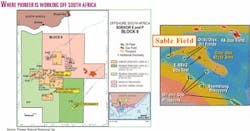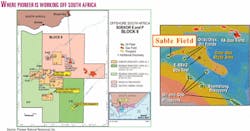Pioneer working to develop oil, gas businesses in South Africa
Pioneer Natural Resources Co., Dallas, will be the first outside company to produce oil off South Africa with the anticipated startup of Sable field expected in the first quarter of 2003. Pioneer also has two natural gas discoveries in the vicinity and foresees South Africa's power generation driving a future gas market.
The company expects an initial gross flow rate of up to 40,000 b/d of light, sweet crude from two reservoirs with 25 million bbl of estimated recoverable oil reserves. Pioneer has a 40% working interest in Sable. PetroSA, the government-owned company, has a 60% working interest and is the designated operator of the field.
"Pioneer's share of Sable field production is expected to increase our worldwide oil production by over 25%. We are excited to be taking this first step in what we expect will be many years of success in South Africa," said Scott Sheffield, Pioneer chairman and CEO.
Meanwhile, Pioneer's largest prospect off South Africa remains undrilled. It is the Gabon Viper prospect and is on the same block as Sable.
Sable field is in 100 m of water 95 km off the southern coast of South Africa. The field is on Block 9 on the Bredasdorp basin. Block 9 is the focus of Pioneer's efforts off South Africa although the company also has acreage extending from Block 7 through Block 14, said Dennis Fagerstone, executive vice-president of international operations.
"When we entered into South Africa, we really had two separate agreements….One agreement involved a development area and another area was an exploration area," Fagerstone said.
The development area is Block 9, which is wedged between the exploration areas of Block 7 and also Blocks 10-14. The exploration areas fall under an agreement with the petroleum agency responsible for minerals leasing. Pioneer plans to drill two additional wells on Block 9 this year.
Bredasdorp basin
Sable is being developed with six subsea wells tied back to a floating production, storage, and offloading (FPSO) vessel, the Glas Dowr owned by Bluewater (UK) Ltd. The FPSO is being modified in England after working for 3 years in the North Sea
PetroSA awarded Bluewater a contract last year to provide and operate an FPSO with capacity to process 60,000 b/d of oil, re-inject 80 MMcfd of gas, and recover natural gas liquids.
Associated gas will be reinjected to improve liquids recovery but could be produced later as part of a larger gas development project.
Sable is not the first producing field in the area. PetroSA operates Oribi and Oryx fields 18 km east of Sable. These fields are of similar size and have been producing for 3 years via an FPSO.
Pioneer is using the Omega rig to drill its development wells. Soekor owns the Omega, but it is contracted to Pride Drilling. Development drilling started in November 2001. Fagerstone said Pioneer has five wells to drill and one existing well to be worked over. "Everything there appears to be moving forward right on schedule," he said.
In addition, Pioneer completed testing of the E-BB2 gas well last year. The well was drilled 120 km south of Mossel Bay to test the lateral continuity and productivity of widespread gas-bearing sands in the center of the Bredasdorp basin. The well found over 325 ft of gas-bearing sandstone in five primary zones. Three of the zones were perforated and tested.
Two of the zones exhibited low permeability while a third zone flowed at a sustained rate of 10 MMcfd of gas and 800 b/d of liquids. Results of wells drilled in this trend are being assessed as part of the larger gas development project currently being evaluated. Pioneer has 40% working interest and operated the well. PetroSA has the remaining 60% and is the designated operator of the tract.
Pioneer also is preparing to drill an appraisal well near a new field discovery on Bredasdorp basin Block 9.
The E-DQ1 discovery well on the Boomslang prospect in 450 ft of water cut 108 ft (128 gross ft) of net pay in synrift shallow-marine sands consisting of an oil leg under a gas column at 6,600 ft.
Part of the oil leg interval flowed at rates up to 3,120 b/d of oil and 2.6 MMcfd of gas. The gas column flowed a constant 24 MMcfd of gas and 300 b/d of condensate for 5 days.
The discovery confirms a prospective oil and gas trend on the basin's southern flank that is similar to the gas producing trend on its northern flank and validates several analogous prospects, Pioneer said.
E-DQ1 is 40 km southeast of Oribi oil field. Pioneer is the operator of the tract with a 49% working interest and Soekor has the remaining 51%. Pioneer also completed the acquisition of a 1,100 sq km 3D seismic survey of the Boomslang trend area where several other prospects have been identified.
Developing gas markets
Pioneer is developing gas reserves and believes markets will not be a problem.
South Africa's two government upstream companies, Mossgas and Soekor, have merged into a company called PetroSA. Pioneer has been a partner with Soekor on Block 9. Mossgas holds the existing gas development rights on Block 9 and the gas-to-liquids plant at Mossel Bay.
With creation of PetroSA, Pioneer becomes a partner with the company that owns the GTL plant.
"We perceive our initial gas market will be feedstock for that plant," Fagerstone said. "We still want to prove up another 200-300 bcf. Then, we will begin to install more infrastructure in the central part of Block 9 to take gas to an existing platform that was installed by Mossgas to produce its gas field. That platform has a pipeline to shore."
Currently, Pioneer has three proved gas accumulations: the Boomslang discovery, the E-BB2 discovery, and Sable oil field, which has associated gas and a gas reservoir in a deeper zone.
"There is a lot of gas in Block 9. Our plan is to develop what we have found, identify some additional accumulations nearby, and further evaluate stepping out and developing more gas. Once we have some infrastructure in place, then it's going to be easier to bring on gas and look for other markets," he said.
The market discussed most frequently is power generation. Fagerstone believes gas-fired generation can be competitive on South Africa's southern coast. Currently, power comes predominately from coal-fired plants and some nuclear power. Electricity is transmitted over long distances from coal mines in northeastern South Africa.
"The GTL plant at Mossel Bay presently buys all its power. So right away, there is a power generation opportunity in conjunction with operating that plant. Initially, the objective would be to develop enough gas as feedstock for the plant, but if we found more gas, there would also be an immediate power generation opportunity for the plant itself. You just start expanding from that," Fagerstone said.
He said it's unclear yet who would build gas-fired power plants, adding it could be the government power company, Eskom, or companies involved in building independent power projects. Such companies are showing an interest in the South African market.
Port Elizabeth
Meanwhile, Pioneer drilled one unsuccessful well on Block 14 off Port Elizabeth and is continuing to explore. The company is processing a 3D seismic survey that it shot there.
"We found sand, but it was wet so we found part of the components that are necessary to make a commercial discovery. We did have some shows. There have been wells drilled in that area that did have shows."
If gas can be found and developed there then Port Elizabeth would be a ready, nearby market, Fagerstone said.
"Port Elizabeth is economically disadvantaged and it is a good natural deepwater port. They are encouraging the build up of economic activity there. There is a possibility if you find enough gas, even in Block 9, that it could go to Port Elizabeth for industrial users….There truly is a variety of different opportunities as this all plays out."

